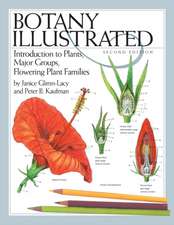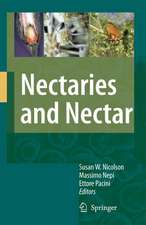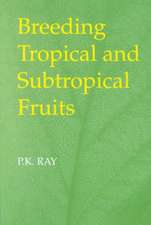Cell Separation in Plants: Physiology, Biochemistry and Molecular Biology: Nato ASI Subseries H:, cartea 35
Editat de Daphne J. Osborne, Michael B. Jacksonen Limba Engleză Paperback – 22 noi 2011
Din seria Nato ASI Subseries H:
- 18%
 Preț: 953.82 lei
Preț: 953.82 lei -
 Preț: 393.13 lei
Preț: 393.13 lei - 15%
 Preț: 643.34 lei
Preț: 643.34 lei - 15%
 Preț: 643.34 lei
Preț: 643.34 lei - 15%
 Preț: 641.03 lei
Preț: 641.03 lei - 15%
 Preț: 642.83 lei
Preț: 642.83 lei - 15%
 Preț: 642.51 lei
Preț: 642.51 lei - 5%
 Preț: 712.81 lei
Preț: 712.81 lei -
 Preț: 392.97 lei
Preț: 392.97 lei - 15%
 Preț: 651.02 lei
Preț: 651.02 lei - 15%
 Preț: 640.24 lei
Preț: 640.24 lei - 18%
 Preț: 948.61 lei
Preț: 948.61 lei - 15%
 Preț: 655.92 lei
Preț: 655.92 lei - 15%
 Preț: 655.92 lei
Preț: 655.92 lei - 15%
 Preț: 653.14 lei
Preț: 653.14 lei - 15%
 Preț: 650.19 lei
Preț: 650.19 lei - 15%
 Preț: 655.13 lei
Preț: 655.13 lei - 15%
 Preț: 652.17 lei
Preț: 652.17 lei - 15%
 Preț: 675.58 lei
Preț: 675.58 lei - 18%
 Preț: 958.07 lei
Preț: 958.07 lei - 18%
 Preț: 961.41 lei
Preț: 961.41 lei - 18%
 Preț: 970.56 lei
Preț: 970.56 lei - 5%
 Preț: 1100.30 lei
Preț: 1100.30 lei - 5%
 Preț: 376.43 lei
Preț: 376.43 lei - 15%
 Preț: 650.86 lei
Preț: 650.86 lei - 15%
 Preț: 644.63 lei
Preț: 644.63 lei - 15%
 Preț: 655.60 lei
Preț: 655.60 lei - 18%
 Preț: 963.47 lei
Preț: 963.47 lei - 15%
 Preț: 648.42 lei
Preț: 648.42 lei - 5%
 Preț: 731.43 lei
Preț: 731.43 lei - 15%
 Preț: 653.14 lei
Preț: 653.14 lei - 18%
 Preț: 960.13 lei
Preț: 960.13 lei - 18%
 Preț: 968.34 lei
Preț: 968.34 lei - 18%
 Preț: 953.97 lei
Preț: 953.97 lei - 15%
 Preț: 654.95 lei
Preț: 654.95 lei - 15%
 Preț: 650.86 lei
Preț: 650.86 lei - 5%
 Preț: 367.64 lei
Preț: 367.64 lei - 5%
 Preț: 1104.68 lei
Preț: 1104.68 lei - 18%
 Preț: 953.20 lei
Preț: 953.20 lei - 15%
 Preț: 651.99 lei
Preț: 651.99 lei - 15%
 Preț: 647.27 lei
Preț: 647.27 lei - 15%
 Preț: 653.00 lei
Preț: 653.00 lei - 15%
 Preț: 656.25 lei
Preț: 656.25 lei - 18%
 Preț: 962.35 lei
Preț: 962.35 lei - 15%
 Preț: 644.82 lei
Preț: 644.82 lei - 15%
 Preț: 666.55 lei
Preț: 666.55 lei - 15%
 Preț: 642.68 lei
Preț: 642.68 lei - 15%
 Preț: 645.96 lei
Preț: 645.96 lei - 15%
 Preț: 651.84 lei
Preț: 651.84 lei
Preț: 652.49 lei
Preț vechi: 767.63 lei
-15% Nou
Puncte Express: 979
Preț estimativ în valută:
124.87€ • 135.59$ • 104.89£
124.87€ • 135.59$ • 104.89£
Carte tipărită la comandă
Livrare economică 22 aprilie-06 mai
Preluare comenzi: 021 569.72.76
Specificații
ISBN-13: 9783642741630
ISBN-10: 3642741630
Pagini: 476
Ilustrații: XVII, 449 p.
Dimensiuni: 170 x 242 x 25 mm
Greutate: 0.75 kg
Ediția:Softcover reprint of the original 1st ed. 1989
Editura: Springer Berlin, Heidelberg
Colecția Springer
Seria Nato ASI Subseries H:
Locul publicării:Berlin, Heidelberg, Germany
ISBN-10: 3642741630
Pagini: 476
Ilustrații: XVII, 449 p.
Dimensiuni: 170 x 242 x 25 mm
Greutate: 0.75 kg
Ediția:Softcover reprint of the original 1st ed. 1989
Editura: Springer Berlin, Heidelberg
Colecția Springer
Seria Nato ASI Subseries H:
Locul publicării:Berlin, Heidelberg, Germany
Public țintă
ResearchCuprins
Section I. Gene Regulation and Gene Expression.- 1. Signals for gene expression in ripening tomato fruit.- 2. Regulation, maturation and function of tomato fruit polygalacturonase.- 3. Characterization and expression of a ripening-induced cellulase gene from avocado.- 4. Gene expression in senescing leaves.- 5. Regulation of ethylene biosynthesis in higher plants: induction and identification of 1-amino-cyclopropane-1-carboxylate synthase.- 6. Auxin- and vound-induced expression of ACC synthase.- 7. Changes in gene expression during ethylene-induced leaf abscission.- 8. The cell biology of bean leaf abscission.- Section II. Cell Wall and Enzyme Changes.- 9. Sorting signals and trafficking of lysosomal and extracellular hydrolases of cell separation.- 10. Extensin peroxidase ties the knots in the extensin network.- 11. Cell wall-derived elicitors — are they natural (endogenous) regulators?.- 12. Polygalacturonase activity in the ripening tomato fruit.- 13. Hormone-regulated modifications to cell wall polysaccharides; relevance to cell separation.- 14. Ethylene and polygalacturonase — what else is involved in cell separation in ripening fruit?.- Section III. Pathogenic Cell Separation.- 15. Signals and cell wall events in plant-pathogen interactions.- 16. Host cell wall loosening and separation by plant pathogens.- 17. The degradation of potato cell walls by pathogens.- Section IV. Signal Specificity and Target Cell Status.- 18. Interference by ethylene with the abscission retarding effects of auxin in citrus leaves.- 19. Identification of leaf abscission zones as a specific class of target cells for ethylene.- 20. IAA mediated cell separation in the sepal splitting of Oenothera lamarkiana flower buds.- 21. Pollination-induced corolla abscission and senescence and therole of short-chain fatty acids in the process.- 22. The abscission process in peach: structural, biochemical and hormonal aspects.- Section V. Cell Separation in Development.- 23. Cell separation: a developmental feature of root caps which may be of fundamental functional significance.- 24. Cell wall changes in ripening peaches.- 25. Regulation of aerenchyma formation in roots and shoots by oxygen and ethylene.- 26. Cell isolation, recognition and fusion during sexual reproduction.- 27. Pectinaceous beads and pectinase on callus cell surfaces in graft unions and in culture.- 28. Signals between plant and bacterial cells: specific domains in cell walls, a new insight.- Section VI. Crop Production and Harvesting.- 29. Bud, flower and fruit drop in citrus and other fruit trees.- 30. Post-harvest berry drop and its control in certain grape varieties.- 31. Olive inflorescence, flower, fruit and leaf abscission with chemicals used for mechanical harvest.- Section VII Additional Contributions.- 32. Putative ethylene binding protein(s) from abscission zones of Phaseolus vulgaris.- 33. Differential abscission and ripening responses to ethylene by tabasco pepper leaves and fruit: protein “marker events” as probes.- 34. Chimeric analysis of cell layer interactions during development of the flower pedicel abscission zone.- 35. The role of ethylene in petal abscission of red raspberry.- 36. Peroxidases and cell wall growth by epicotyls of Cicer arientinum L. Possible regulation by calcium and calmodulin and relationship with cell wall loosening.- 37. A threonine and hydroxyproline-rich glycoprotein from maize.- 38. The role of endosperm degradation in the germination of tomato seeds.- 39. Auxin-derived pear cells in culture as a model system for studying senescence.- 40.Studies on the release of mesophyll protoplasts from Cinchona ledgeriana L..- 41. Cell separation events in Poplar in response to sulphur dioxide and ozone: involvement of ethylene.- 42. Cell wall pectic content as an early signal for cell separation.- Contributor Index.









